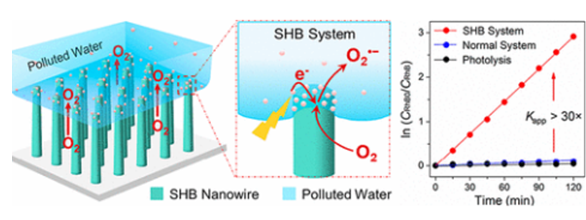Increasing the Efficiency of Photocatalytic Reactions via Surface Microenvironment Engineering
Hang Zhou1, Xia Sheng1, Jie Xiao1, Zhenyao Ding1, Dandan Wang1, Xiqi Zhang2, Jian Liu3, Renfei Wu3, Xinjian Feng1* (封心建), and Lei Jiang4
1College of Chemistry, Chemical Engineering and Materials Science, Soochow University, Suzhou 215123, P. R. China
2Key Laboratory of Bio-inspired Materials and Interfacial Science, Technical Institute of Physics and Chemistry, Chinese Academy of Sciences, Beijing 100190, P. R. China
3Institute of Functional Nano and Soft Materials (FUNSOM), Soochow University, Suzhou 215123, P. R. China
4Key Laboratory of Bio-inspired Materials and Interfacial Science, Technical Institute of Physics and Chemistry, Chinese Academy of Sciences, Beijing 100190, P. R. China; School of Future Technology, University of Chinese Academy of Sciences, Beijing 101407, P. R. China;
J. Am. Chem. Soc.2020, 142, 2738--2743
The use of photocatalysis for water purification and environmental protection is of key interest. However, the reaction kinetics can be limited by the restricted accessibility of electron acceptor oxygen and the low adsorption of organic compounds—crucial factors underlying photocatalytic performance. Here we simultaneously alleviate these constraints via reaction interface microenvironment design using superhydrophobic (SHB) TiO2 nanoarrays as a model photocatalyst. The low surface energy and rough surface microstructure features of the SHB nanoarrays give the photocatalytic system long-range hydrophobic force and an air–water–solid triphase reaction interface. This simultaneously changes the adsorption model of organic compounds and the access pathway of oxygen, leading to a markedly enhanced adsorption capacity and higher interfacial oxygen levels. These synergistic qualities result in over 30-fold higher reaction kinetics versus a normal diphase system. In addition, this photocatalytic system is stable via repeated cycling. Our findings highlight the importance of reaction interface microenvironment design and reveal an effective path for the development of efficient photocatalysis systems.

链接:https://pubs.acs.org/doi/abs/10.1021/jacs.9b12247